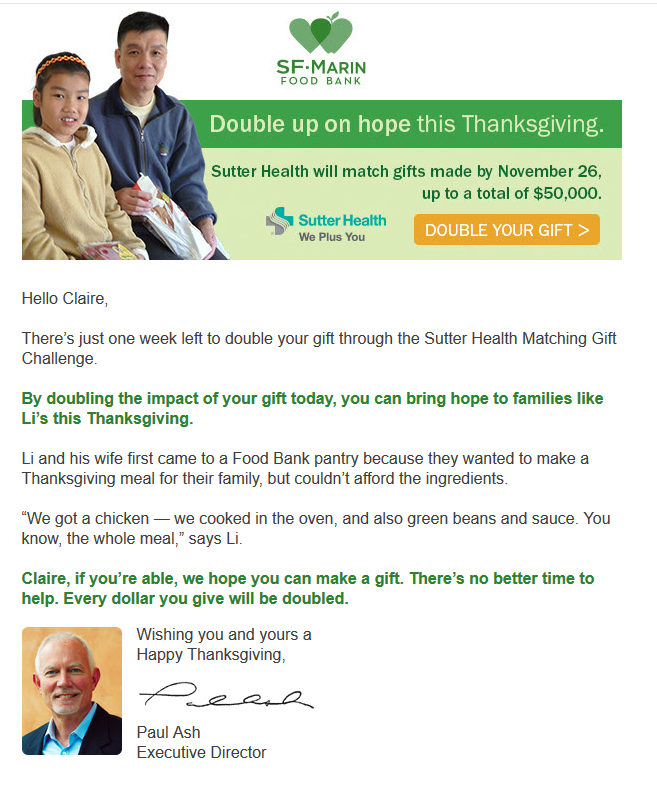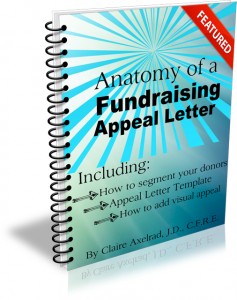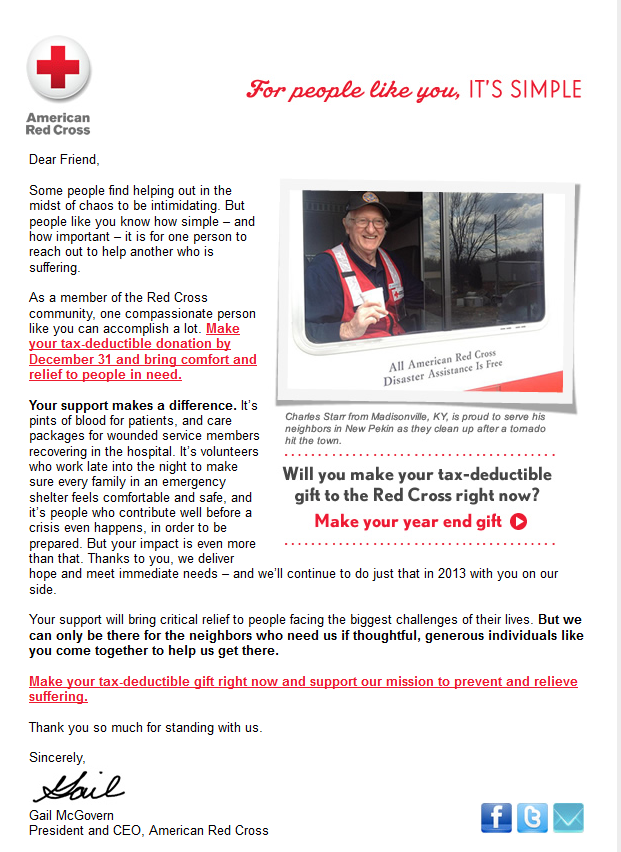
See your year-end appeal take flight by leveraging your offline campaign online.
Here come 15 steps to successful email fundraising.
I’m going to tell you (1) why you should care about this, and (2) what you should do.
Not long ago, I posed the question: Why Aren’t You Doing More Online Fundraising? I hope it caused you to think and ponder a bit.
Now, as you’re no doubt planning ahead for the most giving time of the year, is a good time to turn those thoughts into action. How big a role is email going to play in your year-end fundraising strategy?
If you’re making your email campaign an afterthought, don’t.
Email is a critically important tool — especially at the end of the year when most of the money is raised,
Don’t worry that your donors will be annoyed. If you do it the right way, they won’t be. In fact, they’ll thank you for giving them the opportunity to do something that makes them feel good — and for making it easy for them to do so!.
Let’s begin with the “why”.
Email May Be Your Most Powerful Messaging Tool
In 7 Stats That Reveal the Future of Email Marketing we learn that more than 7 in 10 consumers would prefer to receive email communications over just about anything else — that includes direct mail, texting and social media. And the preference for email extends across age groups and genders. Even Millennials.
(Don’t worry, we’ll get to the “how” – 15 steps to successful email fundraising – shortly.)
First, here are some things you need to know about why email rocks:
- Per Salsa Labs, email has the highest rate of return on investment for any marketing channel – that’s $40 for every $1 spent.
- 5% of marketers believe that email marketing’s ROI will be even higher than it is now by the year 2020.
- 70% of consumers believe email will still exist in 10 years, compared with 60.2% who believe Twitter will stick around and 56.2% who think direct mail will remain. [If you’ve any doubt about this, check out the resources on my Pinterest board: Email Dead?]
- 76% of marketers believe that all email messages will be completely personalized in the next 5 years. One study found personalization increased email opens by 244% and click-throughs by 161%.
- Folks today expect personalized messages tailored to their individual needs and interests. This means you should be segmenting e-appeals based on constituent behavior. This may mean whether they’re a prospect or donor, interested in Program A or B, or the fact that they have a special affiliation with you (e.g., past board, alum, parent, etc.). The more personal you can be, the more relevant your email will be perceived. And relevancy = opens and actions.
- 97% of email is marked as junk, trash or spam. This is why you need a thoughtful strategy. Personalization and segmentation helps avoid this problem, as do giving due consideration to who your email comes “from” and what you include in your subject lines (more on this in the 15 steps below).
- Due to the marketing Rule of 7 (it takes about 7 touches before folks feel comfortable making a purchase decision; it may take even more in today’s information-overload economy), email sets the stage for philanthropic investment. After folks get your message numerous times online – through a combination of emails, e-newsletters, blog posts and social media — they’re prepped to respond to your direct mail appeal.
Let’s take a closer look at how to create an email appeal that’s not perceived as a piece of junk mail, and that does its job of persuading folks to make a philanthropic gift.
15 Steps to Powerful Fundraising Email Content
These are the basic ingredients to get folks to open your email and click on your ‘Donate’ button/link:
1. Don’t land in SPAM.
Did you know nonprofits lose an average of $15,000 in donations due to roughly 12% of email getting stuck in a spam filter? Ways to avoid this include:
- Ask email recipients to add you to their address book.
- Make sure your email service enables (and asks) folks to opt in to receive your emails.
- Include a clear unsubscribe link at the bottom of your emails.
- Use a checker like Spam Assasin find out your email’s risk of being classified spam.
- Make sure your
2. Pay attention to your ‘from’ sender and your subject lines.
These are critically important if you want your emails to get opened. Is your sender a recognized person who your reader will trust? Is your subject line benefit oriented and/or does it raise your reader’s curiosity? Both these things can improve open rates.
3. Optimize your email for mobile.
Up to 50% of those to whom you send your appeal will quite likely use a mobile device to read your emails. By making some simple tweaks, you can ensure a superior experience for these readers.
4. Plan to keep it short.
This is how email appeals differ from direct mail appeals. You don’t have a lot of space, and folks don’t have a lot of time. The more they can grasp your appeal “above the scroll,” the better. Try to keep your e-mail asks to 400 words or less. You can include links to your website to explain additional information, as needed.
 The e-appeal above can be visualized completely above the scroll on a desktop. It includes many key elements of a compelling appeal: (1) Comes from a respected individual at a respected institution; (2) Compelling visual tells a story; (3) Urgency and leverage are conveyed right away via a time-specific matching grant; (4) One story of who the gift will help is told, and (5) Ask is repeated more than once. It could be improved with a specific dollar ask (maybe options were included on the Donation Landing Page) and use of a P.S. to reiterate the ask and the challenge, but it’s a good effort.
The e-appeal above can be visualized completely above the scroll on a desktop. It includes many key elements of a compelling appeal: (1) Comes from a respected individual at a respected institution; (2) Compelling visual tells a story; (3) Urgency and leverage are conveyed right away via a time-specific matching grant; (4) One story of who the gift will help is told, and (5) Ask is repeated more than once. It could be improved with a specific dollar ask (maybe options were included on the Donation Landing Page) and use of a P.S. to reiterate the ask and the challenge, but it’s a good effort.
5. Make it about your reader.
People give to people. Consider email a one-to-one communication. Imagine who you’re writing to, and simply talk to them. Use their first name. Use the words “you” and “your.” Don’t talk about you.
6. Decide on one compelling story you want to tell.
People are wired for stories, and they’ll pay attention to you in a way that facts and figures cannot compete with. Tell a story that tugs at your reader’s heart strings. The decision to give is triggered by the heart, not the head. Emotion trumps reason. Reason is used to rationalize decisions made by emotion.
Here the story is all about the donor as the Unsung Hero. And the appeal is to a very human and universal emotion. Empathy. Benefits to the donor include doing something remarkable for their hometown, and getting a year-end tax deduction.
7. Put a face to your plea for help.
Be aware of the ‘identifiable victim effect.’ Beware the numbing effect of scale and ‘drop in the bucket.’ Show people, with words and images, specifically who or what they are helping.
8. Set specific dollar and purpose goals for your campaign.
How much do you want to raise, for what purpose and within what time frame? What will the donor’s money accomplish? Prepare to offer specifics. And make them about impact, not your monetary campaign goal. Work backwards from your deadline to schedule a series of email appeals that will get you to your goal.
9. Make your calls to action clear.
Always ask yourself: “What do I want folks to do when they receive this message?” Show your donor exactly how they can become your hero. People like to know what you expect of them. Generic appeals that go to generic action buttons simply won’t generate the return on engagement that specifically targeted campaigns will. Donors want to know where their money will go and how it will help.
This outlines a number of specific ways the donor’s gift may be used. The visual tells the story; the caption reinforces it. The text puts the donor into the appeal right away, as someone who understands what needs to be done and won’t be intimidated. Later in the letter, the donor is flattered for being “thoughtful” and “generous.” (Flattery will take you far). The year-end deadline to get your tax-deduction benefit jumps out.
10. Fewer choices translates to greater engagement and investment.
Include just one call to action per email. If you offer too many choices, folks are likely to choose none. It’s called “analysis paralysis.” [Learn more about the famous jam study here]
11. Ask more than once.
People skim emails. You want to make sure they see your call to action. Phrase it a bit differently each time: “Please help.” “Donate.” “Invest now.” “Give.”
Help. Give. Receive. This email takes asking and giving to the point of being reciprocal. It channels the psychological principle of reciprocity — you do something good for us now; we’ll do something good for you later (or, vice-versa: we did something good for you previously; you’ll likely want to return the favor now). There’s a certain Karmic quality to the message “giving to others comes back to strengthen each of us. So, go ahead and HELP.”
12. Make your calls to action urgent.
Leverage your appeal with a challenge grant, or an end-of-year appeal to give to get a tax deduction, or an appeal to give to get folks off your waiting list or prevent doors from closing. Don’t let folks put your appeal aside for later.
13. Make it easy to respond to your call to action.
People like to follow step-by-step directions. “Click here.” “Call.” The less fields your donor has to complete, the more likely they are to follow through to the end.
14. Coordinate all your actions.
Make sure your content, images and design connect, not just across multiple emails but also across multiple channels – website, social media and offline communications. You want to bake repetition into your integrated campaign. This serves not only to reinforce your message but to reassure donors you’re consistent, and they can trust you.
15.Plan for follow-up once your supporter invests.
This is how you’ll retain donors, and in the long-run this is what makes your cost/benefit work out. This means, at minimum, (1) creating a custom, personalized thank you email that folks receive immediately; (2) sending folks to a compelling donation thank you landing page that makes them feel good about the action they just took, and (3) following up with a mailed thank you that reports on the gift’s impact. You should also plan for an ongoing cultivation and stewardship strategy that showers your donors with love and gratitude throughout the year. Sustainable giving is transformational, not transactional.
SUMMARY: Online Strategy Bolsters Offline Strategy
Many nonprofits spend oodles of time developing their direct mail campaign. From theme… to text… to visuals… to design… to who the letter will come from… to envelope teaser copy… to type of stamp… to when the campaign will drop… to how many times you’ll mail… to how you’ll segment your list… to thank you strategy.
Then, at the last minute, they slap a lone email together and send it out. The copy and design may not match their mail campaign. Timing may not be integrated with their offline strategy. There may be no user-friendly donation page or thank you landing page. And the thank you may be an automatically generated receipt.
Yipes stripes — what a half-baked strategy!
You need to spend just as much time – if not more – fully baking your online campaign strategy.
Why? It’s 2017. Everyone, more or less, is online.
Regardless of how your money comes in (and most nonprofits still receive a majority of donations through the mail), you never know what prompted folks to respond So don’t put all your eggs in one basket. Avail yourself of multiple communication channels if you want a prospective donor to respond positively when your mailed appeal crosses their threshold. Even though the bulk of money is still raised offline, it’s no longer enough to simply be in the mail. Plan to touch folks multiple times with your important year-end appeal.
How many touches are you planning for?
The point is not the specific number, but the need for repetition. Buyers just can’t trust you and make the buying (or giving) decision the first time they encounter your message.
So, this simply means your email fundraising campaign effort should be repetitive and consistent. You can’t simply send a one-time email and expect your best results. MailChimp found that the average open rate for nonprofit email marketing is 25.96%, compared to the universal email open rate of 6%. That’s good, but it still means if you send only one e-appeal close to 75% of your constituents will never see it. That should give you pause.
You need to plan thoughtfully, and hedge your bets to assure you reach as many potential supporters as possible. Email can be your friend in this regard.
Seize the year-end momentum to become a skilled email fundraiser!
- Email works.
- It’s relatively inexpensive.
- People like and use it.
- It can be easily shared.
- It sets the table for subsequent communications and calls to action.
- It enables instant response and action.
- You can easily track and measure results.
- It facilitates quick follow-up – impact reporting and gratitude.
Just follow these 15 steps — you can do it!
Get Your Step-by-Step Guide to Crafting a Killer Appeal Letter or Email

This 62-page e-Guide is a surprisingly quick read — and a true road map to creating a winning fundraising appeal
I guarantee you’ll raise more money if you follow the guidelines in my Anatomy of a Fundraising Appeal Letter plus Sample Template. And if you’re not happy for any reason, you’ve got my 30-day, no-questions-asked refund policy. Make the next two months really count! Grab this E-Guide here. To your success!
Image via PhotoIntoPainting
This has been updated from an article originally published in Clairification 11-2016.








